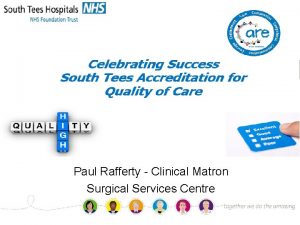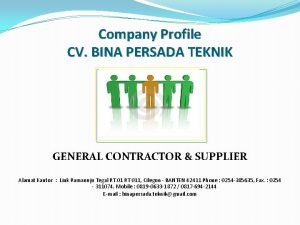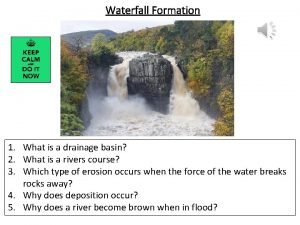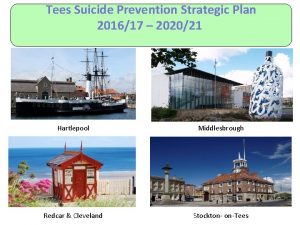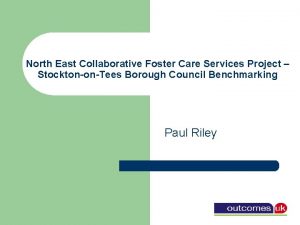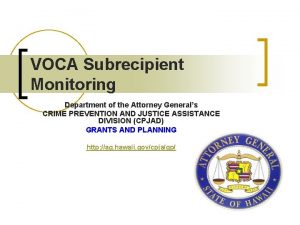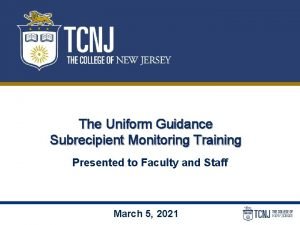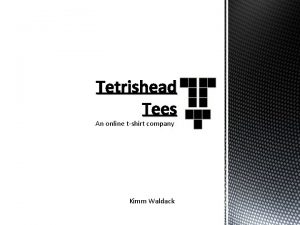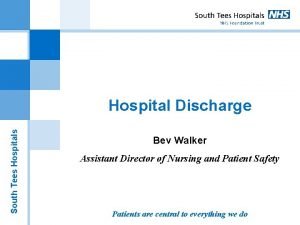CONTRACTOR INFORMATION PRESENTATION South Tees Site Company INFORMATION














- Slides: 14

CONTRACTOR INFORMATION PRESENTATION South Tees Site Company

INFORMATION 1. SUB-CONTRACTORS 2. RISK ASSESMENT CATEGORY 3. ROAD TRAFFIC RULES 4. CCTV 5. COMAH 6. DO’S & DONTS 7. BE AWARE 8. TAKE 2 9. NEAR MISS REPORTING 10. INDUCTION INFORMATION 11. ADDITIONAL INFORMATION 12. SITE MAP

Sub-Contractors Any company engaging Sub-Contractors on STSC Teesside Site, Must ensure that The Sub-Contract Company is Approved Prior to Working On Site

Risk Assessment Category STSC utilises a risk assessment matrix for each contract approval based upon number of estimated man days, against worst case scenario for the activity the contractor carries out. STSC RISK ASSESSMENT MATRIX

Road Traffic Rules Maximum speed is 30 mph with some lower speed restrictions which are signed. There are mobile speed cameras in operation throughout the site. STSC do not permit the use of hands free mobile phones, you must park up and turn off your engine before using a mobile phone. Rail crossings usually have red flashing lights; though not in all cases. . take care. Please note that RAIL traffic has priority in all areas.

CCTV

Control of Major Accident Hazards Regulations 1999 (COMAH) STSC on Teesside is a top tier COMAH Site What are the COMAH Regulations all about? The Control of Major Accident Hazards Regulations ensures that businesses “Take all necessary measures to prevent major accidents involving dangerous substances. Limit the consequences to people and the environment of any major accidents which do occur” and to prevent industrial sites having incidents such as Flixborough, Piper Alpha or major environmental incidents such as Seveso (significant air pollution disaster in Italy). The Teesside Site is a top tier COMAH Site, primarily due to the presence of large quantities of flammable and toxic gases in the iron, steel and cokemaking processes, although there are other major hazards on Site. COMAH – What does it mean to you? Any person, who comes onto the Teesside Site, may potentially be exposed to major accident hazards. Equally, dependent on the nature of the activity, contractors also may have the potential to cause a major accident. COMAH Duties It is a key requirement for the top tier COMAH sites to demonstrate that they have taken “all measures necessary” to prevent major accidents and to limit the consequences to “people and environment” of any that do occur. The Health & Safety Executive recognises that there are three key risk control systems, in particular, which are essential in order to achieve this: 1. Operations: operational control including procedures, safety during maintenance, control of contractors, inspection test and maintenance Permits to Work and decommissioning. 2. Management of Change: organisational, plant, process, design, process variables, materials, equipment, procedures, software, design changes etc. 3. Planning for Emergencies: internal emergency plans, mitigatory measures, inspection, test and maintenance of mitigatory measures, emergency response training, testing of emergency plans. Contractor activity is a key activity and it is, therefore, essential that contractor companies and their employees know what their roles and responsibilities are to prevent and/or mitigate in the event of a major accident. Contractors must be aware of the relevant hazards. How they may cause them, be affected by them and what to do in an emergency. They must comply with works procedure, rules, permits etc and be aware that deviation from these must be assessed (management of change).

DO’S & DON’T’S Health & Safety Awareness Being aware of the hazards and risks around you is vital to being safe. You owe it to yourself, your colleagues, friends and family to act responsibly and implement the appropriate control measures. THE DO’S: • Ensure that you report near misses and/or incidents that have the potential to cause harm. • Ensure that you know the correct procedure in case of an emergency. • Ensure that you are aware of emergency assembly points and containment areas within any location in which you work. • Ensure that you apply the same degree of importance to health and safety as you do to work • Ensure that you consider the implications of your actions on the environment. • Ensure that you understand comply fully with health and safety requirements THE DON’TS • Do not undertake any work unless you have had a Site & Plant Induction • Do not undertake a task or activity that you are NOT competent to do • Do not start work without the necessary equipment to complete the work safely • Do not make changes to the original scope of work/activity unless appropriate risk assessments have been undertaken IF IN DOUBT, ASK

BE AWARE • Material handling: We use a wide range of lifting equipment including cranes, lifting devices, forklift trucks. We must be vigilant at all times. Keep clear of suspended loads. Keep out of the line of fire. • Workplace transport: Observe the rules of the road and speed limits and keep alert to pedestrians and others in your vicinity. When on Site the same rules apply as on public road. All of us must be alert and give vehicles plenty of room. • Working at height: Any work at height requires the provision of adequate protection. This includes work at heights below two meters. Stay within the protection provided by scaffolds and barriers. • Machinery: Our machines have the capability to seriously injure or kill you. Stick to the procedures and permits and make sure the machine is effectively and securely isolated before starting any repair. • Electricity: The essential use of electricity in our lives means risk is ever present. Risks include electrocution, fire and explosion. All equipment should be maintained through regular inspection and only personnel trained to work on electrical systems should carry this out. • Asbestos: Asbestos location records must be consulted before working in any area that may be affected. Always assume suspect material is asbestos and take the relevant precautions until tests prove otherwise. • Slips, trips and falls: Slips, trips and falls on slippery floors, obstructions and uneven ground are a common hazard. Ensure a clean, clear well-ordered workplace and use the handrail on stairs to minimise the risks. • Noise: Although it won’t kill you, consistent exposure to noise will damage your hearing. Observing the mandatory PPE requirements will ensure that you are effectively protected from any threat of damage that may be present. • Confined space: There may be unknown or unexpected contaminants and oxygen deficiency in areas where there is restricted access or egress and specialised equipment may be required for emergencies. Ownership of any confined space activity and risk analysis, including permit to work, is required. • Fire: The three elements of fire – oxygen, fuels and source of ignition - are abundant at our facilities. Suitable risk assessments are required to ensure that control measures are in place and fire-extinguishing equipment is maintained and regularly tested.

‘TAKE 2’ Minutes For Safety The Assessment of Risk in the Workplace ‘Take 2’ is a simple point of work risk assessment system applied by all individuals prior to the commencement of works activities and revolves around a pocket size pad issued during plant inductions. Prior to conducting your activities take 2 minutes to ask yourself the following questions: a) What hazards do I need to consider? . b) Will my work affect others? c) Has my environment changed Each sheet contains 11 assessment questions to be completed prior to the task being conducted - these require a yes/no answer: 1) Have you been briefed on the task. 2) Do you understand the hazards involved and steps to be taken to minimise the risk. 3) Are control measures in place. 4) Are you in possession of the relevant permits. 5) Has the plant been isolated. 6) Has the plant been immobilised. 7) Have you placed your personal danger board. 8) If scaffolding is being used, is it for purpose and scafftag fitted. 9) If lifting equipment is being used, is it for purpose and correctly tagged. 10) Are you wearing the correct PPE. 11) Do you have a valid licence for the equipment being used. Should this process identify any immediate task safety requirements, these must be addressed before the activity is conducted. The assessment sheet remains in the book and on completion of work two final questions require attention: a) Is the work area in a safe condition. b) Is the work area clean and tidy. The assessment sheet should be retained for the working day, this is to allow system demonstration as required, at the end of the working day activity assessment sheets can be removed. The assessment pad also contains ‘Follow up action required’ slips, these should be utilised to record details of arising task actions, when a slip is completed with the required detail is should be removed and handed to the identified owner for action. The pad cover incorporates detailed guidance on matters for consideration including: a) Examples of hazards to consider. b) Permits to consider. c) PPE

NEAR MISS A Near Miss is an unplanned event that did not result in injury, illness, or damage – but had the potential to do so. Only a fortunate break in the chain of events prevented an injury, fatality or damage; in other words, a miss that was nonetheless very near. STSC Operates A Near Miss Reporting process and actively encourages all employees and contractors to report any near miss. All Near Miss incidents Must be reported to the STSC Contract Manager or Local Area Management

Teesside Visitor Centre Inductions Please call the number below or email details to the facilities email address to book site inductions. These inductions are carried out at the main security gate (further plant specific inductions may be required). The induction session typically takes around 20 minutes Visitors/contractors wishing to regularly drive on site must register their vehicle. In conjunction with the Site Induction various specific Plant Area Inductions will need to be completed to allow working on a particular site For further advice & assistance: Tel: Email: Facilities on : - Internal 8771, External : - 01642 408771 facilitieshelpdesk@stscltd. com

Additional Information 1. It is mandatory as a minimum requirement that all contractors working on the STSC Site Hold a Recognised Safety Passport such as CCNSG /ECITB. STSC will also accept the EMSS Safety Passport which can be obtained on line. (See Link for Details) www. nationalsafetypassport. com or www. emssonline. org. 2. Permit Requirements Contract companies working on the STSC site are required to be issued with the appropriate permits providing the necessary controls for the work in hand. These controls will vary according to the nature, location and type of work. All permits are required to be issued and authorised by a responsible person for the work area where the work is to be carried out. 3. Personal Danger Boards It is a requirement that where necessary, for isolation & immobilisation purposes Contractors are required to provide personal danger boards. The exact style and procedure must be agreed with the local contract or Job owner Please use this information pack as a Tool Box Talk to provide vital information to your employees before they visit the STSC Site

STSC SITE 06 September 2011 14
 Staqc south tees
Staqc south tees Company profile cv kontraktor
Company profile cv kontraktor How falls are formed
How falls are formed Tees lpc
Tees lpc Tees strategic plan
Tees strategic plan Busted tees models
Busted tees models River tees meanders
River tees meanders Gerrc paragraph
Gerrc paragraph Fostering stockton on tees
Fostering stockton on tees Tees lpc
Tees lpc Hot site cold site warm site disaster recovery
Hot site cold site warm site disaster recovery Old south vs new south streetcar named desire
Old south vs new south streetcar named desire Subrecipient vs contractor
Subrecipient vs contractor Subrecipient vs contractor
Subrecipient vs contractor Alliant wrap x
Alliant wrap x
